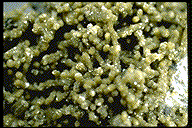 |
The Dolomite Group of Minerals |
The Dolomite Group is composed of minerals with an unusual trigonal bar 3 symmetry. The general formula of this group is AB(CO3)2, where A can be either calcium, barium and/or strontium and the B can be either iron, magnesium, zinc and/or manganese.
The structure of the Dolomite Group is taken from the
Dolomite is a very common mineral and ankerite is much more scarce. The other members are considered rare to very rare. The rarity of the members of this group can be tied to the closeness in radius of the A and B ions. In dolomite the A and B ions are calcium and magnesium which have the largest ionic radius differential of the group (approximately 33%). If the A and B ions are close in radius, then they tend to not segregate as easily into the separate A and B layers, which is required to form this structure and therefore these minerals.
MINERALS THAT BELONG TO THE DOLOMITE GROUP:
- Ankerite Ca(Fe, Mg, Mn)(CO3)2
Benstonite (Ba, Sr)6(Ca, Mn)6Mg(CO3)13- Dolomite CaMg(CO3)2
Huntite CaMg3(CO3)4- Kutnohorite Ca(Mn, Mg, Fe)(CO3)2
Minrecordite CaZn(CO3)2Norsethite BaMg(CO3)2








